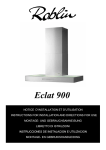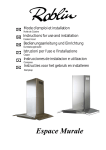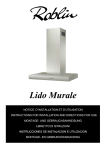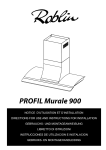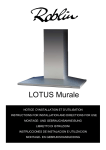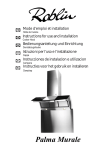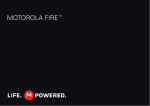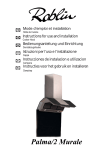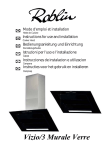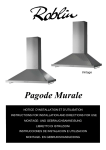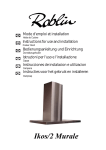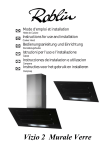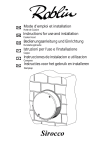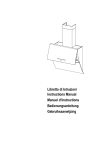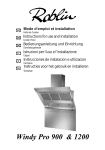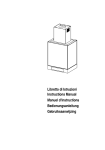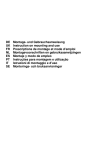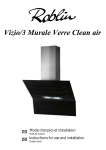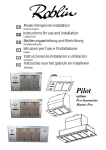Download Imagine / 3 Glass
Transcript
GB Instructions for use and installation DE Bedienungsanleitung und Einrichtung IT Istruzioni per l’uso e l’installazione FR Mode d’emploi et installation NL E Cooker Hood Dunstabzugshaube Cappa Hotte de Cuisine Instructies voor het gebruik en installeren Dampkap Instrucciones de instalacion e utilizacion Campana Imagine / 3 Glass 110.0295.436 110.0295.437 FIM/3 900 W XSG FIM/3 900 W BKG F SOMMAIRE GB CONTENTS RACCORDEMENT ÉLECTRIQUE ELECTRICAL WIRING CONSEILS D’INSTALLATIONS INSTALLATION ADVICE POSE DE L’APPAREIL FITTING THE APPLIANCE FONCTIONNEMENT OPERATION CONSEILS D’UTILISATIONS USEFUL HINTS ENTRETIEN MAINTENANCE GARANTIE ET SERVICE APRÈS-VENTE GUARANTEE AND AFTER-SALES-SERVICES REMARQUES REMARKS D I INHALT CONTENUTI NETZANSCHLUSS COLLEGAMENTO ELETTRICO MONTAGEHILFEN CONSIGLI DI INSTALLAZIONE MONTAGE DES GERÄTES POSA DELL’ APPARECCHIO BETRIEB DES GERÄTES FUNZIONAMENTO NUTZUNG CONSICLI DI UTILIZZO WARTUNG UND REINIGUNG MANUTENZIONE GARANTIE UND KUNDENDIENST GARANZIA ED ASSISTENZA TECNICA WICHTIGE HINVEISE NOTE E NL SUMARIO INHOUD CONEXION ELECTRICA ELECTRISCHE BEDRADING CONSEJOS DE INSTALACION MONTAGE AANWIJZING INSTALACION DEL APARATO AANSLUITEN VAN HET APPARAAT FUNCIONAMIENTO FUNKTIONEREN CONSEJOS DE UTILIZACION GEBRUIKSADVIES MANTENIMIENTO ONDERHOUD GARANTIA Y ASSISTENCIA TECNICA AFTER SALES SERVICE NOTA OPMERKINGEN F Nous vous remercions de la confiance que vous nous avez accordée en choisissant un appareil de la gamme FRANKE. Celui-ci a fait l’objet de toute notre attention dans sa conception et sa réalisation. Afin qu’il vous donne entière satisfaction, nous vous recommandons de lire avec attention cette notice qui vous expliquera comment l’installer, l’utiliser et l’entretenir dans les meilleures conditions. La présente notice d’emploi vaut pour plusieurs versions de l’appareil. Elle peut contenir des descriptions d’accessores ne figurant pas dans votre appareil. 1 RACCORDEMENT ÉLECTRIQUE. • La hotte est équipée d’un cordon d’alimentation de type HO5VVF 3 x 0,75 mm² comportant une fiche normalisée 10/16 A avec système de mise à la terre. Mode de protection : classe 1. Tension d’alimentation : 220-240 V mono - 50/60Hz. Vérifier que la tension du secteur est identique aux valeurs indiquées sur la plaque signalétique à l’intérieur de la hotte • Si la hotte est raccordée directement sur le réseau sans sa fiche, un interrupteur omnipolaire avec une ouverture de contact de 3 mm doit être installé avant la hotte. Le fil de terre (Jaune / vert) ne doit pas être interrompu par cet interrupteur. 2 CONSEILS D’INSTALLATION. • Pour un fonctionnement idéal, nous vous conseillons une plage de hauteur de pose qui se situe de 0,65 m à 0,70 m au-dessus du plan de cuisson. Toutefois, il est formellement interdit d’installer toute hotte ou groupe d’aspiration à une distance inférieure à 0,65 m du plan de travail (risque d’inflammation des filtres). La fumée doit monter naturellement vers la zone de captation. • Respecter le diamètre de sortie de l’appareil : la hotte ne doit en aucun cas être raccordée à un conduit de ventilation mécanique contrôlée (V.M.C.). • Lorsqu’on évacue l’air vicié dans un conduit d’évacuation, veiller à ce que celui-ci ne soit pas déjà exploité à véhiculer des gaz ou fumées provenant d’appareils alimentés par une énergie autre qu’électrique. • Positionner le plan de cuisson au plus près de l’évacuation et éviter la formation de coudes sur la gaine, afin de réduire au maximum les pertes de charges. • Dans tous les cas d’installation, veiller au bon renouvellement d’air de la cuisine. Penser à effectuer une ou des entrées d’air par une grille de section égale ou supérieure au diamètre du tuyau d’évacuation, afin de ne pas mettre la cuisine en dépression. • Prévoir une aération suffisante lorsqu’un appareil de cuisson ou autre utilise simultanément l’air ambiant de la pièce où est installée la hotte. • La dépression maximum crée dans la pièce doit être inférieure à 0.04 mbar, ce qui évite un retour de gaz de combustion. • L’appareil doit être positionné de telle façon que la fiche d’alimentation soit accessible. • Cet appareil ne doit pas être utilisé par des personnes (y compris les enfants) ayant des capacités psychiques, sensorielles ou mentales réduites, ni par des personnes n’ayant pas l’expérience et la connaissance de ce type d’appareils, à moins d’être sous le contrôle et la formation de personnes responsables de leur sécurité. Les enfants doivent être surveillés pour s’assurer qu’ils ne jouent pas avec l’appareil. 3 POSE DE L’APPAREIL. Montage et raccordement doivent être réalisés par un installateur* qualifié. (*) Le non-respect de cette condition entraîne la suppression de la garantie du constructeur et tout recours en cas d’accident. Attention: prendre bien soin d’employer les chevilles adaptées au support, se renseigner au près des fabricants, effectuer un scellement si nécessaire. La société décline toute responsabilité en 1 F cas d’accrochage défectueux dû au perçage et chevillage. 1) Tracer sur la paroi une verticale jusqu’au plafond à l’emplacement de la hotte au centre de la zone prévue pour le montage de la hotte (Fig.1, rep. 1). Cette ligne sert pour aligner verticalement les différentes parties. 2) Positionner le support de conduit ( Rep. 2), centré sur la verticale à 1 à 2 mm du plafond ou de la limite supérieure et marquer sur la paroi les deux alésages du support. Effectuer sur la paroi deux trous avec un foret Ø 8 mm. Fixer le support de conduit (Rep. 2) à l’aide des vis 4.5 x 50 et des chevilles fournies. 3) Définir le bas de la hotte (Rep 3) afin de fixer les supports au mur (Fig 3, Rep 4). Marquer un point sur la ligne verticale à une distance du plan de cuisson de : d = 1070 min (mesure sans crédence). d = hauteur crédence (400 mm) + 670 mm (mesure avec crédence). La hauteur H est la hauteur minimum en mm du plan de cuisson au bas de la hotte (Rep. 3). Crédence (Option) : La hauteur de la hotte par rapport au plan de cuisson est déterminée, dans ce cas par la hauteur de la crédence Rep B et par l’éventuel dosseret du plan de travail. La crédence doit être montée avant le corps de la hotte et si l’on désire la fixer contre le mur tant en haut qu’en bas, il est nécessaire de la positionner à la juste hauteur. Etant donné qu’il s’agit d’une opération compliquée, elle doit être effectuée exclusivement par l’installateur de la cuisine ou par du personnel compétent connaissant toutes les dimensions finales des meubles. Effectuer sur la paroi 4 trous avec un foret Ø 8 mm. Fixer les support (Rep. 4) à l’aide des vis 4.5 x 45 et des chevilles fournies. 4) Montage du corps de la hotte : Accrocher le corps (Rep 5) sur les supports muraux. Parfaire le réglage d’alignement de l’ensemble, à l’aide des vis TH 5 x 25 des supports, ainsi que l’inclinaison à l’aide des 2 vis 5 x 25 mm TC. Après avoir effectué tous les réglages d’alignement de l’ensemble de la hotte, verrouiller celle-ci par une vis de fixation positive (Rep 8), afin de garantir la sécurité d’accrochage. 5) Raccordement: • Pour la version Evacuation Extérieure : a- Mettre en place le clapet anti-retour (Rep. 8) sur la sortie de l'appareil (Rep. 6), puis le telescopique et raccorder le tuyau flexible (Fig. 6) à l’évacuation extérieure et la sortie de l’appareil . Fixer l’ensemble à l’aide de colliers ou de ruban adhésif appropriés. b- Enlever le filtre à graisse , puis s'assurer que le connecteur du cable d'alimentation soit bien branché dans la prise du moteur (Fig. 5).Raccorder électriquement la hotte (Voir paragraphe Raccordement Electrique) et vérifier le bon fonctionnement de l’éclairage, du moteur et du changement des vitesses d’aspiration. c- Emboîter le haut de conduit dans le bas de conduit télescopique (Fig. 1 - Rep. 7a & b) et fixer le haut de conduit au support Rep. 2 par 2 vis M4 Rep. 12c fournies. Puis coulisser le bas de conduit jusqu’au bloc moteur. d- Mettre en place les 3 déflecteurs (Rep. 9) • Pour la version Recyclage: a- Fixer le déflecteur Rep. R sur la fixation du haut de conduit, le déflecteur est fixé avec les mêmes vis que le support de haut de conduit (Fig. 2 - Rep. 2). b- Installer un tuyau de diamètre approprié (Non fourni) entre la sortie de l’appareil et à l’entrée du déflecteur. Fixer l’ensemble à l’aide de colliers ou de ruban adhésif appropriés. c- Enlever le filtre à graisse, puis s'assurer que le connecteur du cable d'alimentation soit bien branché dans la prise du moteur (Fig. 5). Raccorder électriquement la hotte (Voir paragraphe Raccordement Electrique) et vérifier le bon fonctionnement de l’éclairage, du moteur et du changement des vitesses d’aspiration. d- Placer la cartouches à charbon actif dans son logement en exerçant une pression sur les languettes A (Fig. 4). e- Emboîter le haut de conduit dans le bas de conduit télescopique (Fig. 1 - Rep. 7a & b) et fixer le haut de conduit au support Rep. 2 par 2 vis M4 Rep. 12c fournies. Puis coulisser le bas de conduit jusqu’au bloc moteur. f- Mettre en place les 3 déflecteurs (Rep. 9) • Pour la version sans moteur et sans conduit : 2 F Note : Les Fig. 7 & 8 correspondent aux versions sans moteur et sans conduit (SMC ou WMC). 4 FONCTIONNEMENT A B C E D F G H Tableau des commandes Touche Fonction A Allume et éteint le moteur d’aspiration à la dernière vitesse utilisée B Diminue la vitesse de service. C Augmente la vitesse de service. D Met en marche la vitesse intensive de n’importe quelle vitesse, même à moteur éteint ; cette vitesse est temporisée à 10 minutes, après quoi, le système retourne à la vitesse réglée au préalable. Idéale pour faire face à des émissions maximales de fumées de cuisson. E Met en marche le moteur à une vitesse permettant une aspiration de 100 m3/h pendant 10 minutes toutes les heures ; après quoi le moteur s’arrête. F Active l’arrêt automatique après un délai de 30’. Idéale pour éliminer complètement les odeurs résiduelles. Peut être activée depuis n’importe quelle position, appuyer sur la touche ou éteindre le moteur pour désactiver la fonction. G Appuyer sur la touche pendant environ 2 secondes pour rétablir l’alarme signalant la saturation des filtres à l’état initial H Allume et éteint l’éclairage. Afficheur Affiche la vitesse réglée. Les segments allumés diminuent. Les segments allumés augmentent. I clignote et les segments sur l’afficheur sont tous allumés. Appuyer sur la touche pour désactiver. 24 s’affiche et les segments qui sont tous allumés sur l’afficheur s’éteignent un à un de façon cyclique. Appuyer sur la touche pour désactiver. Le symbole d’une Horloge qui clignote s’affiche. Appuyer sur la touche pour désactiver. Après 100 heures de fonctionnement, le symbole Goutte s’affiche pour signaler la saturation des filtres métalliques. Après 200 heures de fonctionnement, C s’affiche pour signaler la saturation des filtres au charbon actif. Commande de blocage du clavier : il est possible de bloque le clavier, par exemple pour effectuer le nettoyage du verre, quand le moteur et l’éclairage de la hotte sont éteints. Appuyer sur la touche F (Retard) pendant environ 5 secondes pour activer ou désactiver le blocage du clavier, qui est toujours confirmé par un bip sonore et une animation sur la barre du moteur de l’afficheur. 3 F 5 CONSEILS D’UTILISATION • Pour obtenir une efficacité maximum d’absorption des fumées ou des vapeurs, faire fonctionner l’appareil 5 minutes environ avant et après la cuisson des aliments; La première vitesse est conseillée pour les cuissons à feu doux et pour les sauces. La deuxième pour les cuissons soutenues, grillades et friteuses. La troisième est indiquée pour les cuissons à forte émanation de graisses et vapeur. • IMPORTANT . NE JAMAIS FLAMBER DE METS AU DESSOUS DE L’APPAREIL Ne laissez jamais de flammes libres sous la hotte en fonctionnement. • Les fritures nécessitent une surveillance permanente, l’huile surchauffée pouvant s’enflammer. 6 ENTRETIEN Déconnecter le câble d’alimentation pour toute intervention électrique. L’appareil a été conçu pour faciliter au maximum les opérations d’entretien, synonyme de bon fonctionnement et rendement de l’appareil dans le temps. • Nettoyage des filtres métalliques. Il est indispensable de procéder à un NETTOYAGE PÉRIODIQUE de ces filtres à la main (avec un détergent liquide à l’eau tiède et rinçage) ou au lave- vaisselle (tous les deux mois environ pour une utilisation normale). • Carrosserie. Nettoyer régulièrement celle-ci en utilisant des produits détergents, non abrasifs et une éponge légèrement humide. N’utilisez jamais d’éponges ou de chiffons trempés. N’introduisez aucun objet, ni les mains dans l’ouverture servant à l’évacuation de l’air. • Conduit d’évacuation. Vérifier tous les 6 mois le bon écoulement de l’air vicié. Observer les prescriptions réglementaires locales concernant l’évacuation de l’air vicié. • Éclairage. Avant toute intervention sur l’appareil, mettre l’interrupteur d’allumage des lampes en position éteinte. Ne pas dépasser la puissance prescrite et ne pas changer de type de lampe. 7 GARANTIE ET SERVICE APRÈS-VENTE • En cas d’anomalie de fonctionnement, prévenez votre installateur qui devra vérifier l’appareil et son raccordement. • Dans le cas où un composant électrique viendrait à être endommagé, celui-ci ne peut être remplacé que par un atelier de réparation reconnu par le fabricant, car des outils spéciaux sont nécessaires. • Débrancher complètement l’appareil. • Exigez toujours l’utilisation de pièces de rechange d’origine. La non observation de cette prescription peut compromettre la sécurité de l’appareil. • Lors de la commande de pièces détachées, rappeler le numéro de l’appareil inscrit sur la plaque signalétique située à l’intérieur de la hotte. • Seule la facture d’achat de l’appareil fera foi pour l’application de la garantie contractuelle. Cette garantie ne couvre pas les consommables comme : - L’éclairage : lampes incandescentes, halogènes ... - Les filtres. 8 REMARQUES Cet équipement est conforme à la norme européenne sur la basse tension 2006/95/CE relative à la sécurité électrique et aux normes européennes: 2004/108/CE relative à la compatibilité électromagnétique et 93/68 relative au marquage CE. d’une poubelle à roue barrée est attaché à un produit, cela signifie que le Lorsque ce symbole produit est couvert par la Directive Européenne 2002/96/EC. Votre produit est conçu et fabriqué avec des matériaux et des composants de haute qualité, qui peuvent être recyclés et utilisés de nouveau. 4 F Veuillez vous informer du système local de séparation des déchets électriques et électroniques. Veuillez agir selon les règles locales et ne pas jeter vos produits usagés avec les déchets domestiques usuels. Jeter correctement votre produit usagé aidera à prévenir les conséquences négatives potentielles contre l’environnement et la santé humaine. 5 GB Thank you for buying a FRANKE product which has been manufactured to the highest quality standards to meet your requirements. We recommend you carefully read this booklet in which you will find instructions for installation, hints for use and maintenance. The Instructions for Use apply to several versions of this appliance. Accordingly, you may find descriptions of individual features that do not apply to your specific appliance. 1 ELECTRICAL • This cooker hood is fitted with a 3-core mains cable with a standard 10/16A earthed plug. • Alternatively the hood can be connected to the mains supply via a double-pole switch having 3mm minimum contact gap on each pole. • Before connecting to the mains supply ensure that the mains voltage corresponds to the voltage on the rating plate inside the cooker hood. • Technical Specification: Voltage 220-240, single phase ~50/60Hz. 2 INSTALLATION ADVICE • Ensure the cooker hood is fitted in compliance with the recommended fixing heights. • To ensure the safe operation of this cooker hood, we recommend that the hood should not be fitted below 65cm (for electric) or (70cm for gas) the measurements taken from the surface of the cooking appliance to the underside of the cooker hood. • It is a possible fire risk if the hood is not sited as recommended. • To ensure the best results, the cooking fumes should be able to rise naturally towards the inlet grilles on the underside of the cooker hood and the cooker hood should be positioned away from doors and windows, which will create turbulence. • Ducting • If the room where the hood is to be used contains a fuel-burning appliance such as a central heating boiler then its flue must be of the room sealed or balanced flue type. • If other types of flue or appliances are fitted ensure that there is an adequate supply of fresh air to the room. Ensure the kitchen is fitted with an airbrick, which should have a cross-sectional measurement equivalent to the diameter of the ducting being fitted, if not larger. • The ducting system for this cooker hood must not be connected to any existing ventilation system, which is being used for any other purposes or to a mechanically controlled ventilation ducting. • The ducting used must be made from fire retardant materials and the correct diameter must be used, as incorrect sized ducting will affect the performance of this cooker hood. • When the cooker hood is used in conjunction with other appliances supplied with energy other than electricity, the negative pressure in the room must not exceed 0.04 mbar to prevent the fumes from combustion being drawn back into the room. • The appliance is for domestic use only and should not be operated by children or people who are infirm without supervision. • This appliance must be positioned so that the wall socket is accessible. • This appliance is not intended for use by persons (including children) with reduced physical, sensory or mental capabilities, or lack of experience and knowledge, unless they have been given supervision or instruction concerning use of the appliance by a person responsible for their safety. Children should be supervised to ensure that they do not play with the appliance. 3 FITTING Any permanent electrical installation must comply with the latest regulations concerning this type of installation and a qualified electrician must carry out the work. Non-compliance could cause serious accidents or injury and would deem the manufacturers guarantee null and void. IMPORTANT - The wires in this mains lead are coloured in accordance with the following code : - green / yellow : earth - blue : neutral - brown : live As the colours of the wires in the mains lead of this appliance may not correspond with the coloured 6 GB markings identifying the terminals in your plug, proceed as follows. - The wire which is coloured green and yellow must be connected to the terminal in the plug which is marked with the letter E or by the earth symbol or coloured green or green and yellow. - The wire which is coloured blue must be connected to the terminal which is marked with the letter N or coloured black. - The wire which is coloured brown must be connected to the terminal which is marked with the letter L or coloured red. ATTENTION: Do not forget to use adequate plugs to the support brackets. Enquire after the manufacturers. Do an embedding if necessary. The manufacturer accepts no responsibility in case of a faulty hanging due to the drilling and the setting up of plugs.GB 1) Draw a vertical line onto the wall from the centre of the cooking appliance up to the ceilling, using a spirit level and a marker pen as illustrated in Fig. 1 - item 1. This is to ensure the correct alignment of the chimney hood. 2) Place the brackets item 2 on the wall about 1 or 2 mm from the ceiling or from the upper limit, aligning its centre on the vertical line. Mark the two eyelet holes of the bracket onto the wall. Drill the holes for the fixing bracket using an 8 mm masonry bit. Fix the chimney bracket item 2 using the 4.5 x 50 mm screws and rawl plugs supplied. 3) Mark a point on the vertical line at a distance from the cooking appliances of: d = 1070 mm (Measurement without splashback). d = height of the splashback (400 mm) + 670 mm (Measurement with splashback). The distance H is the minimum height in mm from the cooking appliances to the bottom edge item 3 of the front panel of the hood. Draw a horizontal line through the vertical as illustrated in Fig. 1. Splashback (optional): When a splashback is to be fitted, the distance between the hood and the cooking appliances will be determined by the height of the splashback item B and whether or not there is a raised back on the worktop. The splashback is to be installed before installing the canopy. If the splashback is to be fixed to the wall using both the top and bottom fixing holes, Care must be taken to ensure that the splashback is fitted at the correct height before fixing the base units or at least the worktop covering them. As this is a complex operation, it should only be undertaken by the technician installing the kitchen units or by a competent person who knows the final dimensions of the units. Mark the hole centres for the canopy fixing brackets item 4 at item B mm as illustrated in Fig. 3. Drill the 4 holes for the fixing brackets using an 8 mm masonry bit. Fix the wall brackets item 4 using the 4.5 x 45 mm screws and rawl plugs supplied. 4) Hook the canopy item 5 onto the wall brackets item 4 as illustrated in Fig. 3. To ensure the cooker hood is aligned correctly adjust the screws on the top of the canopy as illustrated in Fig. 3. When the hood is aligned correctly mark the hole centre on the wall for the security fixing screw item8, which is located in the right hand bracket on the top of the canopy. Unhook the canopy from the wall and drill the hole for the security fixing screw. Hook the canopy onto the wall and fix the No 4,5 x 50mm headed screw and rawl plug to secure the canopy to the wall. 5) Ducting: The hood is more effective when used in the extraction mode (ducted to the outside). When the cooker hood is ducted to the outside, charcoal filters are not required.The ducting used must be 150 mm (6 INS), rigid circular pipe and must be manufactured from fire retardant material, produced to BS.476 or DIN 4102-B1. Wherever possible use rigid circular pipe which has a smooth interior, rather than the expanding concertina type ducting. Maximum length of ducting run: - 4 metres with 1 x 90° bend. - 3 metres with 2 x 90° bends. - 2 metres with 3 x 90° bends. The above assumes our 150 mm (6 INS) ducting is being installed. Please note ducting components and ducting kits are optional accessories and have to be ordered, they are not automatically sup- 7 GB plied with the chimney hood. IN THE EXTRACTION MODE: a. Place the anti-backflow flats item 8 over the round outlet item 6, the telescopic duct and connect the ducting 150mm (6 INS) over the round outlet on top of the canopy and secure the connections with appropriate clamping rings or adhesive tape (Fig. 6). b. Remove the grease filters (see paragraph Maintenance) Fig. 5 being sure that the connector of the mains cable is correctly inserted in the socket placed on the sides of the fan. Before fitting the chimney to the canopy make the electrical connection as described in the section titled ELECTRICAL. When the electrical connection has been made, test the lights and the fan motor. c. Each chimney stack consists of two sections. Fit the upper sections (Fig. 1 - item 7a & b) first by expanding the chimneys slightly to allow them to clamp around the bracket item 2 and secure the chimney stacks to the brackets using the two M4 screws item 12c provided. Fit the lower chimney sections by expanding the chimneys slightly to allow them from the top of the canopy to clamp around the upper chimney sections. d. Fit the 3 deflectors Item 9. IN THE RECIRCULATION MODE: a. Fit the recirculation spigot R onto the upper chimney wall bracket using the same fixing screws (Fig. 2 item 2). b. Connect the ducting 150mm (6 INS) not provided between motors item 6 and the recirculation spigot and secure the connections with appropriate clamping rings or adhesive tape. c. Remove the grease filters (see paragraph Maintenance) Fig. 5 being sure that the connector of the feeding cable is correctly inserted in the socket placed on the side of the fan. Before fitting the chimney to the canopy make the electrical connection as described in the section titled ELECTRICAL. When the electrical connection has been made, test the lights and the fan motor. d. Insert the charcoal filter into the base of the motor housing and secure the filter with two metal securing straps item A as illustrated in Fig. 4. e. Each chimney stack consists of two sections. Fit the upper sections (Fig. 1 - item 7a & b) first by expand-ing the chimneys slightly to allow them to clamp around the bracket item 2 and secure the chimney stacks to the brackets using the two M4 screws item 12c provided. Fit the lower chimney sections by expanding the chimneys slightly to allow them from the top of the canopy to clamp around the upper chimney sections. f. Fit the 3 deflectors Item 9. IN THE REMOTE MOTOR MODE AND WITHOUT CHIMNEY: Note: The Fig. 7 & 8 correspond to the versions without Motor and without chimney (SMC or WMC). 8 GB 4 OPERATION A B C E D F G H Control panel Button A B C D E F G H Function Turns the suction motor on and off at the last speed used. Decreases the working speed. Increases the working speed. Activates intensive speed from any other speed, including motor off. This speed is timed to run for 10 minutes, after which the system will return to the speed that was previously set. Suitable for dealing with severe cooking fumes. Starts the motor at a speed that allows a suction of 100 m3/h for 10 minutes every hour, after which the motor stops. Activates automatic switch-off with a 30’ delay. Suitable to complete elimination of residual odours. Can be activated from any position, it is deactivated by pressing the button of turning the motor off. Performs a Reset of the Filter saturation alarm when the button is pressed for approximately 2 seconds. Turns the Lighting System on and off. Display Displays the speed set. Decreases the lighted segments. Increases the lighted segments. I flashes and the segments on the Display are all lit. It is disabled by pressing the Button. Displays 24 and the segments on the Display, initially all lit, turn off one at a time in cycle. It is disabled by pressing the Button. Displays a flashing Clock symbol. It is disabled by pressing the Button. After 100 hours operation the Drop symbol is displayed to indicate saturation of the Metal Grease Filters. After 200 hours operation the letter C is displayed to indicate saturation of the Activated Charcoal Filters. Keyboard Lock Command: it is possible to lock the keyboard, for example when cleaning the Glass, when the Hood Motor and Lights are turned off. Press F (Delay) for approximately 5 seconds to enable or disable Keyboard Locking, which is always confirmed by a Beep and an animated signal on the display motor bar. 9 GB 5 USEFUL HINTS • To obtain the best performance it is advisable to switch ‘ON’ the cooker hood a few minutes (in the boost setting) before you start cooking and you should leave it running for approximately 15 minutes after finishing. • IMPORTANT: NEVER DO FLAMBÉ COOKING UNDER THIS COOKER HOOD • Do not leave frying pans unattended during use as over-heated fat and oil might catch fire. • Do not leave naked flames under this cooker hood. • Switch ‘OFF’ the electric and gas before removing pots and pans. • Ensure heating areas on your hotplate are covered with pots and pans when using the hotplate and cooker hood simultaneously. 6 MAINTENANCE Before carrying out any maintenance or cleaning isolate the cooker hood from the mains supply. The cooker hood must be kept clean; a build up of fat or grease can be a fire hazard. Casing • Wipe the cooker hood frequently with a clean cloth, which has been immersed in warm water containing a mild detergent and wrung out. • Never use excessive amounts of water when cleaning particularly around the control panel. • Never use scouring pads or abrasive cleaners. • Always wear protective gloves when cleaning the cooker hood. Metal Grease Filters The metal grease filters absorb grease and dust during cooking to help keep the cooker hood clean inside. The grease filters should be cleaned once a month or more frequently if the hood is used for more than 3 hours per day. To remove and replace the metal grease filters • Remove the metal grease filters one at a time by releasing the catches on the filters; the filters can now be removed. • The metal grease filters should be washed, by hand, in mild soapy water or in a dishwasher. • Allow to dry before replacing. Active Charcoal Filter The charcoal filter cannot be cleaned. The filter should be replaced at least every three months or more frequently if the hood is used for more than three hours per day. To remove and replace the filter • Remove the metal grease filters. • Press against the two retaining clips, which hold the charcoal filter in place and this will allow the filter to drop down and be removed. • Clean the surrounding area and metal grease filters as directed above. • Insert the replacement filter and ensure the two retaining clips are correctly located. • Replace the metal grease filters. Extraction tube. Check every 6 months that the dirty air is being extracted correctly. Comply with local rules and regulations with regard to the extraction of ventilated air. Lighting. If the lamp fails to function check to ensure it is fitted correctly into the holder. If lamp failure has occurred then it should be replaced with identical replacement. Do not replace with any other type of lamp and do not fit a lamp with a higher rating. 7 GUARANTEE AND AFTER SALES SERVICE • In the event of any malfunction or anomaly, notify your fitter who will have to check the appliance and its connection. 10 GB • In the event of damage to the mains supply cable, this can only be replaced by at approved repair centre appointed by the manufacturer who have the necessary tools and equipment to carry out any repairs properly. Repairs carried out by other persons will invalidate the guarantee. • Use only genuine spare parts. Should these warnings fail to be observed it could affect the safety of your cooker hood. • When ordering spare parts quote the model number and serial number written on the rating plate, which is found on the casing behind the grease filters inside the hood. • Proof of purchase will be required when requesting service. Therefore, please have your receipt available when requesting service as this constitutes the date from which your guarantee commenced. This Guarantee does not cover : - Damage or calls resulting from transportation, improper use or neglect, the replacement of any light bulbs or filters or removable parts of glass or plastic. These items are considered to be consumable under the terms of this guarantee. 8 REMARKS This appliance complies with European regulations on low voltages Directive 2006/95/CE on electrical safety, and with the following European regulations: Directive 2004/108/CE on electromagnetic compatibility and Directive 93/68 on EC marking. When this crossed-out wheeled bin symbol is attached to a product it means the product is covered by the European directive 2002/96/EC.Your product is designed and manufactured with high quality materials and components, which can be recycled and reused.Please inform yourself about the local separate collection system for electrical and electronic product. Please act according to your local rules and do not dispose of your old products with your normal household waste. The correct disposal of your old product will help prevent potential negative consequences for the environment and human health. OPERATION 11 D Wir danken Ihnen für Ihre Kaufentscheidung und das Vertrauen, welches Sie mit dem Kauf dieses FRANKEProduktes bewiesen haben. Dieses Gerät wurde mit einem hohen Maß an Kreativität entwickelt und mit größter Sorgfalt gefertigt. Um volle Zufriedenheit mit Leistung und Funktion dieser Dunstesse zu erlangen und zu erhalten, empfehlen wir dringend, sowohl die Montageanweisung sorgfältig zu beachten und danach zu arbeiten als auch die « Gebrauchs- und Wartungshinweise « aufmerksam zu lesen und anzuwenden. Diese Gebrauchsanleitung gilt für mehrere Geräte-Ausführungen. Es ist möglich, dass einzelne Ausstattungsmerkmale beschrieben sind, die nicht auf Ihr Gerät zutreffen. 1 NETZANSCHLUSS • Die Dunstabzugshaube ist mit einer Anschlußleitung der Art HO5VVF 3 x 0,75 mm2, die einen Schutzstecker 10 / 16 A enthält, ausgestattet. Das entspricht Schutzklasse 1. Nennspannung : 220-240 V - Wechselstrom : 50/60 Hz. • Es ist sicherzustellen, daß die Netzspannung den Anschlußwerten auf dem Typenschild im Inneren der Dunstesse entspricht. • Beim Anschluß der Dunstesse an das Wechselstromnetz ist ein zweipoliger Schalter mit einem Öffnungsweg von wenigstens 3 mm für jeden Pol zwischenzuschalten. 2 MONTAGEHILFEN • Die Mindest- und Höchstabstände zwischen der Dunstesse und der Kochfläche sind zu berücksichtigen. Wir empfehlen Ihnen einen Abstand von 0,65 m bis 0,70 m über der Kochfläche einzuhalten, um einen optimalen Betrieb des Gerätes zu gewährleisten. Jedoch ist es streng verboten, Dunstessen oder Einbaugeräte mit einem Abstand, der niedriger als 0,65 m von der Kochfläche ist, einzubauen (Entzündungsgefahr der Filter). Beachten Sie die richtige Ableitung der Kochschwaden (Luftzug kann Turbulenzen verursachen). • Der Außendurchmesser am Gebläseabgang des Gerätes ist für die Wahl des Abluft-Rohrsystems zu berücksichtigen : Die Dunstesse darf keinesfalls an eine Entlüftungsleitung mit Unterdruck angeschlossen werden. Die Abluft darf nicht in einen Schornstein geleitet werden, der für die Abgase von Koch- oder Heiz-Geräten, (Kohle-, Öl- oder Gas-Öfen oder -Herde) benutzt wird. • Die Kochstelle (und damit auch die Dunstesse) so planen und installieren, daß möglichst kurze Wege für eventuelle Abluft-Rohrleitungen erreicht werden. (so wenige Umlenkungen [90°-Bögen] wie möglich! Keine Querschnittsverengungen! • Die gute Erneuerung der Luft in der Küche ist zu beachten. Denken Sie daran, einen oder mehrere Lufteintritte durch eine Öffnung, die den gleichen Durchmesser hat wie die Abluftleitung, vorzusehen. • Sorgen Sie für eine ausreichende Zuluft, wenn ein Koch- oder anderes Gerät die Luft des Raumes, in dem die Dunstesse eingebaut ist, gleichzeitig verwendet. Ein gefahrloser Betrieb ist möglich, wenn bei gleichzeitigem Betrieb von Dunstesse und Feuerstätte im Raum ein Unterdruck von höchstens 0.04 mbar erreicht wird und ein Rücksaugen der Feuerstättenabgase vermieden wird. Das Gerät muß so installiert werden, daß der Geräte-Stecker leicht erreichbar ist. • Dieses Gerät darf nicht von Personen, auch Kindern, mit verminderten psychischen, sensorischen und geistigern Fähigkeiten, oder von Personen ohne Erfahrung und Kenntnisse benutzt werden, sofern sie nicht von für ihre Sicherheit verantwortlichen Personen beaufsichtigt und beim Gebrauch des Geräts angeleitet werden. Kinder dürfen sich nicht unbeaufsichtigt in der Nähe des Geräts aufhalten und auf keinen Fall mit dem Gerät spielen. 3 MONTAGE DES GERÄTES Montage und Anschluß müssen von einem qualifizierten Installateur* durchgeführt werden. (*) Wenn diese Bedingung nicht eingehalten wird, wird die Garantie des Herstellers, sowie jeder Anspruch im Falle eines Unfalles aufgehoben. Achtung ! Bitte beachten Sie bei der Montage das Gewicht der kompletten Dunstesse. Die Tragfähigkeit der Decke oder alternativ der Trägerplatte für diese Zugbelastung muss vor der Montage 12 D geprüft und gegebenenfalls durch die Anbringung von geeigneten Befestigungs-oder Stabilisierungselementen hergestellt werden. Kann eine hinreichende Tragfähigkeit nicht sichergestellt werden, ist von einer Montage abzusehen. 1) An der Wand eine vertikale Linie 1 (Abb. 1) bis zur Decke zeichnen (Mittellinie des Bereiches, indem die Haube montiert werden soll), um die zu montierenden Einzelteile vertikal ausrichten zu können. 2) Einen der beiden Bügel 2 (Abb. 1) ca. 1-2 mm von der Decke oder der oberen Begrenzung an die Wand legen und den Mittelpunkt auf der vertikalen Linie ausrichten. Die beiden ösenförmigen Bohrlöcher des Bügels an der Wand markieren. 3) Einen Punkt auf der vertikalen Linie kennzeichnen, der folgenden Abstand zur Kochmulde aufweist: d = min. 1070 (Maß ohne Rückwand). d =Rückwandhöhe (400 mm) + 670 mm (Maß mit Rückwand). Das Maß H ist die Mindesthöhe in mm von der Kochmulde zur unteren Frontkante 3. Rückwand (Optional): Der Abstand der Haube von der Kochmulde wird in diesem Fall von der Höhe der Rückwand B und des eventuell anzubringenden Aufsatzes an der Arbeitsplatte bestimmt. Die Rückwand wird vor Montage des Haubenkörpers angebracht; will man die Rückwandoben und unten mit der Wand verschrauben, muss sie auf die gewünschte Höhe ausgerichtet werden, bevor der Unterschrank oder die Arbeitsplatte montiert wird. Da es sich hierbei um einen relativ komplizierten Vorgang handelt, sollte er nur vom Küchenmontagepersonal oder von fachlich geschulten Personen, die die Endmasse der Möbel genau kennen, durchgeführt werden. Für die Unterkante des Gerätes eine Einbauhöhe (3) bestimmen,um die Stützen zu positionieren. (Figur 3, Pos. 4) (Abb. 1& 2) 4) Montage des Haubenkörpers: Der Haubenkörper (5) wird an den Wandstützen befestigt. Die Regelung und das Ausrichten der Dunstesse von außen mit den Schrauben 5 x 10 der Stützenund mit den zwei Schrauben 5 x 25 mm kontrollieren. Nachdem Sie alle Einstellungen durchgeführt haben, verriegeln Sie die Dunstesse durch dieBefestigungsschraube (8), um das unbeabsichtigte Aushängen zu vermeiden. Diese positiveBefestigungsschraube ist durch eine farbige Aufschrift gekennzeichnet, die sich im Oberteil desGeräte-Gehäuses befindet. 5) Anschluss für Abluft- oder Umluftbetrieb: • Abluftbetrieb a- Die Rückstauklappe (Pos .8) am Gerätsausgang anbringen (Pos. 6), der Teleskopscheide auf den Flansch des Gerätes einfügen. Schlauch am Gerätsausgang anbringen (Abb. 6) und anschliessen. Beim Anschluss passende Schlauchschellen oder Klebeband benutzen. b- Entfernen Sie die Fettfilter (s. Abschnitt „Wartung“) und versichern Sie sich, dass die Kabelverbindung in die Steckdose des Gebläses einwandfrei montiert wird (Abb. 5). Das Gerät ans Wechselstromnetz anschliessen (siehe Abschnitt Netzanschluss) und Funktion von Beleuchtung, Motor und der elektronischen Steuerung (Gebläseleistung) prüfen. c- Den Oberkamin in den Teleskop-Unterkamin (Abb.1 Pos.7 a+b) einfügen und mit den beigelegten Schrauben M 4 (Pos. 12 c) an die Stütze (Pos. 2) hängen. Danach den Oberkamin um den Haubenkörper falzen. d- die 3 Ablenkplatten Pos. 9 festzulegen. • Umluftbetrieb a- Den Umluftadapter R an den Oberkamin hängen. Der Umluftadapter wird mit denselben Schrauben wie für die Oberkaminstütze befestigt (Abb. 2 – Pos. 2). b- Ein Verbindungsrohr/Schlauch mit passendem Durchmesser (nicht im Lieferumfang) am Lufteintritt des Umluftadapters und am Gebläseausgang (Pos. 6) anschliessen. Beim Anschluss passende 13 D Schlauchschellen oder Klebeband benutzen. c- Entfernen Sie die Fettfilter (s. Abschnitt „Wartung“) und versichern Sie sich, dass die Kabelverbindung in die Steckdose des Gebläses einwandfrei montiert ist (Abb. 5). Das Gerät ans Wechselstromnetz anschliessen (siehe Abschnitt Netzanschluss) und Funktion von Beleuchtung, Motor und der elektronischen Steuerung (Gebläseleistung) prüfen. d- Die Stütze der Aktivkohle-Filters befestigen und mittels Druck auf die Elemente A (Abb. 4) AktivkohleFilterkassette einrasten. e- Den Oberkamin in den Teleskop-Unterkamin (Abb.1 Pos.7 a+b) einfügen und den Oberkamin mit den beigelegten Schrauben M 4 ( Pos. 12 c) an die Stütze (Pos. 2) hängen. Danach den Oberkamin um den Haubenkörper falzen. f- die 3 Ablenkplatten Pos. 9 festzulegen. • Ohnemotorbetrieb und ohne Kamin Bemerkung : Die Abb. 7 & 8 sind für Versionen ohne Motor und ohne Kamin ( SMC oder WMC). 14 D 4 BETRIEB DES GERATES A B C E D F G H Schalttafel Taste Funktion A Schaltet den Motor der Absauganlage bei der zuletzt verwendeten Geschwindigkeit ein und aus. B Vermindert die Betriebsgeschwindigkeit. C Erhöht die Betriebsgeschwindigkeit. D Aktiviert von jeder Geschwindigkeit aus, auch bei abgestelltem Motor, die Intensivgeschwindigkeit, die auf 10 Minuten zeitgeregelt ist. Nach Ablauf dieser Zeit kehrt das System zu der zuvor eingestellten Geschwindigkeit zurück. Für die Beseitigung von sehr intensiven Kochdünsten geeignet. E Aktiviert den Motor bei einer Geschwindigkeit, die eine Absaugleistung von 100 m3/h für die Dauer von 10 Minuten jede Stunde ermöglicht, nach dessen Ablauf hält der Motor an. F Aktiviert das automatische Ausschalten mit einer Verzögerung von 30’. Ermöglicht die Beseitigung von Restgerüchen. Kann von jeder Position aus eingeschaltet werden und wird durch Drücken der Taste oder abstellen des Motors ausgeschaltet. G Führt durch ca. 2 Sekunden langes Drücken der Taste ein Reset des Filtersättigungsalarms aus. H Schaltet die Beleuchtung ein oder aus. Display Zeigt die eingestellte Geschwindigkeit an. Die leuchtenden Segmente nehmen ab. Die leuchtenden Segmente nehmen zu. I blinkt und alle Segmente auf dem Display leuchten. Wird durch Drücken der Taste ausgeschaltet. Zeigt 24 an und alle auf dem Display angezeigten Segmente erlöschen allmählich nacheinander. Wird durch Drücken der Taste ausgeschaltet. Zeigt das Symbol einer blinkenden Uhr an. Wird durch Drücken der Taste ausgeschaltet. Nach 100 Betriebsstunden zeigt das Symbol Tropfen die Sättigung der Metallfilter an. Nach 200 Betriebsstunden zeigt C die Sättigung der Aktivkohlefilter an. Steuerbefehl Tastatursperre: Die Tastatur lässt sich, z.B. zur Reinigung der Scheiben, sperren, wenn Motor und Beleuchtung der Haube ausgeschaltet sind. Zum Aktivieren oder Deaktivieren der Tastatursperre die Taste F (Delay) ca. 5 Sekunden lang drücken. Der Vorgang wird immer durch einen Piepton und die Motorbalkenanzeige auf dem Display bestätigt. 15 D 5 NUTZUNG • Um ein optimales Absaugen der Kochschwaden zu erzielen, wird empfohlen, das Gerät vor dem Kochen einzuschalten und nach dem Kochen noch einige Zeit nachlaufen zu lassen. Für die Speisen, die wenig Dampf entwickeln, verwenden Sie vorzugsweise die kleine Geschwindigkeit. • WICHTIG : NIEMALS UNTER DEM GERÄT FLAMBIEREN. Niemals eine große Flamme bei eingeschalteter Dunstesse unbedeckt lassen. Wenn der Topf weggenommen wird, ist die Flamme abzuschalten oder für einen kurzen Zeitraum auf kleinste Stellung zu drehen, trotzdem aber unbedingt im Auge zu behalten. Frittiergeräte, die unter der Dunstesse betrieben werden, sind während der gesamtem Betriebsdauer zu beaufsichtigen: überhitztes Öl kann sich entzünden und die Haube in Brand setzen. 6 WARTUNG UND REINIGUNG Vor jedem Eingriff in das Gerät immer den Netzstecker ziehen, oder die Sicherung herausdrehen bzw. die Stromzufuhr unterbrechen. Bei der Konstruktion des Gerätes wurde besonders die Wartungs-Freundlichkeit berücksichtigt. • Herausnehmen des Metallfilters : Es ist unerläßlich, diese Filter REGELMÄßIG falls notwendig auch in kurzen Intervallen, mit der Hand (lauwarmes Wasser mit Waschmittel und Spülen) oder in der Geschirrspülmaschine zu REINIGEN. Diese Maßnahmen vermindern die Brandgefahr (starke Fettrückstände sind leicht brennbar). • Gehäuse. Keine nassen Tücher für die Reinigung der Oberflächen der Dunstesse verwenden. Es sollen nur milde Reinigungsmittel und leicht feuchte Tücher verwendet werden. Keine Gegenstände in die Luftaustrittsöffnung stecken. Nicht in die Luftaustrittsöffnung greifen. • Abluftleitung: Kontrollieren Sie von Zeit zu Zeit, daß der Luftkanal nicht verstopft ist. Diese Prüfung muß halbjährlich durchgeführt werden. Die behördlichen Anforderungen, für die Ableitung der Abluft, sind zu berücksichtigen. • Beleuchtung: Bei Leuchtmittel-Wechsel in jedem Fall den Schalter der Beleuchtung ausschalten. Die Art des Leuchtmittels nicht wechseln. Leistung nicht überschreiten. 7 GARANTIE UND KUNDENDIEST • Bei Versagen des Gerätes benachrichtigen Sie Ihren Installateur, der das Gerät und seine Installation überprüfen wird. • Wenn die Geräte-Zuleitung beschädigt wurde, darf diese nur von einer Reparaturwerkstatt ersetzt werden, die von dem Hersteller anerkannt ist, weil Sonderwerkzeuge nötig sind. Haube komplett abschalten. • Stets nur Original-Ersatzteile verwenden. • Sollte diese Vorschrift nicht eingehalten werden, könnte die Sicherheit des Gerätes beeinträchtigt werden. Außerdem erlischt die Garantie. • Bei der Bestellung von Ersatzteilen geben Sie bitte die Nummer des Gerätes, die sich auf dem Typenschild hinter dem Gehäuse befindet, an. • Für die Anwendung der vertraglicher Garantie wird nur die Einkaufsrechnung des Gerätes verbindlich anerkannt. Von der Garantieleistung ausgenommen sind: - Die Beleuchtung : Klassik - und Halogenbeleuchtung - Die Filter (Die Filter sind als Verbrauchsgut anzusehen). 8 WICHTIGE HINWEISE Dieses Gerät entspricht den europäischen Niederspannungsrichtlinien 2006/95/EWG zur elektrischen Sicherheit, den europäischen Richtlinien 2004108/EWG zur elektromagnetischen Verträglichkeit und den Richtlinien 93/68/EWG zur CE Kennzeichnung. 16 D Das Symbol auf dem Produkt oder seiner Verpackung weist darauf hin, dass dieses Produkt nicht als normaler Haushaltsabfall zu behandeln ist, sondern an einem Sammelpunkt für das Recycling von elektrischen oder elektronischen Geräten abgegeben werden muss. Durch Ihren Beitrag zum korrekten Entsorgen dieses Produktes schützen Sie die Umwelt und die Gesundheit Ihrer Mitmenschen. Umwelt und Gesundheit werden durch falsches Entsorgen gefährdet. Weitere Informationen über das Recycling dieses Produktes erhalten Sie von Ihrer kommunalen Behörde, den örtlichen Müllentsorgungsunternehmen oder von Ihrem Fachhändler. 17 I La ringraziamo per la fiducia accordataci nell’aver scelto un prodotto della gamma FRANKE. Questo apparecchio è stato studiato e realizzato con la massima cura, secondo i più alti criteri di qualità. Le Le racraccomandiamo di leggere attentamente questo opuscolo, nel quale troverà le istruzioni per installare, utilizzare e conservare al meglio il suo apparecchio ed ottenere dal suo acquisto il massimo dei benefici. Questo libretto di istruzioni per l’uso è previsto per più versioni dell’ apparec-chio. É possibile che siano descritti singoli particolari della dotazione, che non riguardano il Vostro apparecchio. 1 COLLEGAMENTO ELETTRICO • La cappa é dotata di un cavo di alimentazione di tipo HOSVVF 3x 0,75 mm² e comporta una spina normalizzata 10/16 A con sistema di terra. Protezione : classe 1. Tensione di alimentazione : 220-240 V mono - 50/60 Hz. Verificare che la tensione di rete sia identica ai valori indicati sull’etichetta all’interno della cappa. • Se la cappa é collegata direttamente all’impianto elettrico senza la sua spina, è necessario istallare prima della cappa un interruttore omnipolare con un’apertura di contatto di 3 mm.senza interrompere il filo della terra (giallo/verde). 2 CONSIGLI DI INSTALLAZIONE • Per un funzionamento ideale, vi consigliamo un’altezza di posa situata entro 0,65 m e 0,70 m al di sopra del piano di cottura. Tuttavia, é formalmente vietata l’istallazione di qualsiasi cappa o gruppo aspirante ad una distanza inferiore a 0,65 m dal piano di cottura (rischio di incendio dei filtri). I fumi devono salire naturalmente verso la zona aspirante (attenzione alla correnti d’aria che potrebbero provocare delle turbolenze). • Rispettare il diametro di uscita dell’apparecchio : la cappa non deve in alcun caso essere collegata ad un condotto di ventilazione meccanica controllata (V.M.C.). • Qualora l’aria viziata fosse scaricata in un condotto d’evacuazione, verificare che quest’ultimo non sia già utilizzato per evacuare gas o fumi provenienti da apparecchi alimentati da un’energia diversa da quella elettrica. • Posizionare il piano di cottura in corrispondenza della zona di evacuazione della cappa ed evitare la posa di gomiti che ne potrebbero ridurre la potenza. • In tutti i casi di istallazione, fare attenzione al ricambio d’aria della cucina. Istallare una o più griglie d’aerazione di misura uguale o superiore al diametro del tubo di evacuazione per evitare di mettere il locale in depressione. • Prevedere un’aerazione sufficiente qualora un apparecchio di cottura o altro utilizzi simultaneamente l’aria dell’ambiente in cui é situata la cappa. La depressione massima creata nel locale deve deve essere essere inferiinferiore a 0,04 mbar per evitare un ritorno di gas di combustione. • L’apparecchio deve essere posizionato in modo che la spina sia accessibile. • Questo apparecchio non deve essere utilizzato da persone (bambini inclusi) con ridotte capacità psichiche, sensoriali o mentali, oppure da persone senza esperienza e conoscenza, a meno che non siano controllati o istruiti all’uso dell’apparecchio da persone responsabili della loro sicurezza. I bambini devono essere supervisionati per assicurarsi che non giochino con l’apparecchio. 3 POSA DELL’ APPARECCHIO Il montaggio ed il collegamento devono esere realizzati da un istallatore qualificato *. (*) Il non rispetto di questa condizione provocherà l’annullamento della garanzia del costruttore e tutti i ricorsi in caso di incidente. Attenzione: usare dei tasselli adatti al supporto, informarsi presso i fabbricanti, effettuare una sigillatura se necessario. La società declina ogni responsabilità in caso di agganciatura difettosa dovuta alla perforazione ed al fissaggio. 1) Tracciare sulla parete una linea verticale fino al soffitto, al centro della zona prevista per il montaggio della cappa (Fig. 1, rif. 1); questa operazione serve ad effettuare l’allineamento verticale delle diverse parti della cappa. 18 I 2) Posizionare il supporto del camino sulla parete (Fig. 1 , rif. 2), allineando il suo centro sulla linea verticale, ad 1-2 mm.dal soffitto o dal limite superiore. Segnare sulla parete i due fori asolati del supporto. Forare la parete con una punta Ø 8 mm e fissare il supporto (Rif. 2) usando le viti (12a) 4.5 x 50 ed i tasselli in dotazione. 3) Segnare un punto sulla linea verticale ad una distanza dal piano di cottura di: d = 1070 min (misura senza fondale). d = altezza fondale (400 mm) + 670 mm (misura con fondale). La misura H é l’altezza minima in mm dal piano di cottura al bordo inferiore della cappa (Rif. 3). Definire la posizione della parte bassa della cappa (rif 3) per fissare i supporti (Fig3, rif 4). • Fondale (opzionale): L’altezza della cappa dal piano di cottura è determinata, in questo caso, dall’altezza del fondale B e dalla eventuale alzatina del piano di lavoro. Il fondale va montato prima di montare il corpo cappa, e, se si desidera fissarlo contro la parete sia nella parte superiore che nella parte inferiore, è necessario montarlo alla giusta altezza, prima del montaggio delle basi o almeno del relativo piano superiore. Essendo questa operazione complessa, va effettuata esclusivamente dall’installatore della cucina o da personale competente che conosca tutte le dimensioni finali dei mobili. 4) Montaggio del corpo cappa : Appendere la cappa (rif 5) sui supporti murali.Perfezionare l’allineamento dell’insieme dall’esterno con l’aiuto delle viti dei supporti TH 5 x 25 el’inclinazione con l’aiuto delle 2 viti 5 x 25 mm TC. Dopo aver effettuato tutti gli allineamenti dell’insieme della cappa, bloccarla con una vite di fissagiopositivo (rif 8) per garantirne la sicurezza. Questa vite é reperibile grazie ad un’etichetta colorata esi trova nella parte alta della struttura della cappa. 5) Connessione • Per la versione evacuazione esterna : a- Mettere la valvola di non ritorno (Rif. 8) sull’uscita dell’apparecchio (Rif. 6), )Incastrare l’elemento del tubo telescopico e raccordare il tubo flessibile (Fig. 6) all’evacuazione esterna ed all’uscita dell’apparecchio. Fissare l’assieme tramite collari o nastro adesivo appropriati. b- Togliere i filtri metallici, poi verificare che il connettore del cavo di alimentazione sia ben inserito nella presa del motore (Fig. 5). Raccordare elettricamente la cappa (vedi paragrafo Collegamento Elettrico) e verificare il buon funzionamento delle luci, del motore e del cambiamento delle velocità di aspirazione. c- Infilare la parte alta del camino nella parte bassa del camino telescopico (Fig. 1, rif. 7a & b) Fissarla al supporto (Rif. 2) con 2 viti M4 fornite (Rif. 12c). Far scivolare il camino inferiore fino al blocco motore. d- Fissare i 3 deflettori Rif. 9. • Per installazione in versione filtrante: a- Fissare il deflettore (Rif. R) al supporto del camino superiore. Il deflettore è fissato con le stesse viti del supporto del camino superiore (Fig. 2, Rif. 2) b- Istallare un tubo di diametro appropriato (non fornito) e raccordarlo all’uscita dell’apparecchio ed all’entrata del deflettore. Fissare l’assieme tramite collari o nastro adesivo appropriati. c- Togliere i filtri metallici, poi verificare che il connettore del cavo di alimentazione sia ben inserito nella presa del motore (Fig. 5). Raccordare elettricamente la cappa (vedi paragrafo Collegamento Elettrico) e verificare il buon funzionamento delle luci, del motore e del cambiamento delle velocità di aspirazione. d- Posizionare le cartucce a carbone attivo negli appositi alloggiamenti, esercitando una pressione sulle linguette A (Fig. 4). e- Camino superiore: Allargare leggermente i due bordi laterali (Fig. 7, Rif. 7a) ed agganciarli dietro. Infilare la parte alta del camino nella parte bassa del camino telescopico (Fig. 1, Rif. 7a & b) Fissare il camino superiore al supporto (Rif. 2) con 2 viti M4 fornite (Rif.12c) poi far scivolare il camino inferiore fino al blocco motore. f- Fissare i 3 deflettori Rif.9. • Per la versione senza motore e senza camino : Nota: Le figure 7 e 8 corrispondono alle versioni senza motore e senza camino (SMC o WMC). 19 I 4 FUNZIONAMENTO A B C E D F G H Quadro comandi Tasto Funzione A Accende e spegne il motore di aspirazione all’ultima velocità utilizzata. B Decrementa la velocità di esercizio. C Incrementa la velocità di esercizio. D Attiva la velocità intensiva da qualsiasi velocità anche da motore spento, tale velocità è temporizzata a 10 minuti, al termine del tempo il sistema ritorna alla velocità precedentemente impostata. Adatta a fronteggiare le massime emissioni di fumi di cottura. E Attiva il motore ad una velocità che consente un’aspirazione di 100 m3/h per 10 minuti ogni ora, terminati il motore si ferma. F Attiva lo spegnimento automatico ritardato di 30’. Adatto per completare l’eliminazione di odori residui. Attivabile da qualsiasi posizione, si disattiva premendo il tasto o spegnendo il motore. G Effettua il Reset dell’allarme saturazione Filtri premendo il Tasto per circa 2 Secondi. H Accende e spegne l’impianto di illuminazione. Display Visualizza la velocità impostata. Diminuiscono i segmenti accesi. Aumentano i segmenti accesi. Lampeggia I e i segmenti sul Display sono tutti accesi. Si disattiva premendo il Tasto. Visualizza 24 e i segmenti sul Display da tutti accesi si spengono uno alla volta ciclicamente. Si disattiva premendo il Tasto. Visualizza il simbolo di un Orologio che lampeggia. Si disattiva premendo il Tasto. Dopo 100 ore di Funzionamento Visualizza il simbolo Goccia per segnalare la saturazione dei Filtri Metallici. Dopo 200 ore di Funzionamento Visualizza C per segnalare la saturazione dei Filtri al Carbone Attivo. Comando Blocco Tastiera: è possibile bloccare la tastiera, ad esempio per effettuare la pulizia del Vetro, quando la Cappa ha il Motore e le Luci spente. Premendo per circa 5 Secondi il tasto F (Delay) si può abilitare o disabilitare il Blocco Tastiera che è sempre confermato con un Beep e un’animazione sulla barra motore del display. 20 I 5 CONSICLI DI UTILIZZO • Per ottenere il massimo dell’efficacia per quanto riguarda l’assorbimento dei fumi o del vapore, mettere in funzione l’apparecchio prima e dopo la cottura degli alimenti ; per le preparazioni che producono poco vapore, utilizzare di preferenza le velocità più basse. • IMPORTANTE : NON CUCINARE MAI PIATTI ALLA FIAMMA SOTTO LA CAPPA. Non lasciate mai fiamme libere sotto una cappa funzionante. Spegnere la fiamma o ridurla al minimo per un tempo ridotto e sotto sorveglianza. • Se cucinate delle fritture, abbiate cura di farlo con attenzione costante : l’olio surriscaldato potrebbe infiammarsi. 6 MANUTENZIONE Staccare il cavo di alimentazione prima di qualsiasi intervento elettrico. L’apparecchio é stato pensato per facilitare al massimo le operazioni di manutenzione, sinonimo di buon funzionamento e rendimento nel tempo. • Pulizia dei filtri metallici. E’ necessario procedere ad una PULIZIA PERIODICA dei filtri a mano (con un detergente liquido diluito in acqua tiepida e risciacquo) oppure in lavastoviglie , con una frequenza che dipenderà dall’utilizzo, per evitare i rischi di incendio. • Struttura esterna. Pulire regolarmente la parte esterna utilizzando dei detergenti non abrasivi ed una spugna leggeremente umida. Non utilizzare mai spugne o panni bagnati. Non introdurre alcun oggetto e tanto meno le mani nell’apertura d’evacuazione dell’aria. • Condotto d’evacuazione. Verificare ogni 6 mesi la buona evacuazione dell’aria viziata. Rispettare le norme nazionali vigenti relative all’evacuazione dell’aria viziata. • Illuminazione. Prima di effettuare qualsiasi intervento sull’apparecchio, mettere l’interruttore di accensione delle lampade in posizione spenta. Non superare la potenza prescritta e non cambiare tipo di lampada. 7 GARANZIA ED ASSISTENZA TECHNICA • In caso di anomalia di funzionamento, avvisare il vostro istallatore il quale dovrà verificare l’apparecchio ed il suo collegamento. Nel caso in cui il cavo fosse danneggiato, dovrà essere sostituito esclusivamente da un centro di riparazione consigliato dal fabbricante, poiché la riparazione prevede l’utilizzo di attrezzature apposite. • Staccare la spina dell’apparecchio. • Esigete sempre l’utilizzo di pezzi di ricambio originali in quanto il non rispetto di questa prescrizione potrebbe compromettere la sicurezza dell’apparecchio e metterebbe fine al contratto di garanzia. • Per ordinare i pezzi di ricambio, indicare il numero dell’apparecchio che si trova sull’etichetta segnaletica. • Solo la fattura d’acquisto farà fede ai fini dell’applicazione della garanzia contrattuale. Questa garanzia non copre: - L’illuminazione : lampade ad incandescenza, alogene. - I filtri. In quanto sono considerati come materiali di consumo. 8 NOTE Quest’apparecchio é conforme alla norma europea sulla bassa tensione 2006/95/CE relativaalla sicurezza elettrica e alle norme europee: 2004/108/CE relativa alla compatibilità elettromagnetica e C.E.E. 93/68 relativa alla marcatura CE. 21 I Quando ad un prodotto è attaccato il simbolo del bidone con le ruote segnato da una croce, significa che il prodotto è tutelato dalla Directiva Europea 2003/96/EC. Questo prodotto è stato progettato e fabbricato con materiali e componenti di alta qualità, che posssono esere riciclati e riutilizzati.Si prega di informarsi in merito al sistema locale di raccolta differenziata per i prodotti elettrici ed elettronici.Rispettare le norme locali in vigore e non smaltire i prodotti vecchi nei normali rifiuti domestici. Il correto smaltimento del prodotto aiuta ad evitare possibili conseguenze negative per la salute dell’ambiente e dell’uomo. 22 E Le agradecemos la confiancia que nos participan ustedes elegiendo un aparato de la gama FRANKE quienfue el objeto de toda nuestra atención en su concepción y realisación. Para que les de entera satisfacción, les aconsejamos ustedes leer con atención esta noticia que les explicara ustedes como utilisarle y mantenerle en las mejores condiciones. Esta noticia de instrucciones esta utilizada para varios aparatos. Puede contener descripciones de accessorios no utilizados en su proprio aparato. 1 CONEXION ELECTRICA • La campana esta dotada de un cable de alimentación del tipo HOSVVF 3x 0,75 mm² y permite un cable de conexión normalizada 10/16 A con conexión a tierra. Protección : clase 1’. Tensión de alimentación : 220-240 V mono - 50/60 Hz. Verificar que la tensión de la red sea idéntica a los valores indicados en la etiqueta que se encuentra dentro de la campana. • Si la campana esta conectada directamente a la instalación eléctrica sin su cable de conexión, será necesario instalar antes que la campana, un interruptor omnipolar con una abertura de contacto de 3 mm. sin interrumpir la toma a tierra (amarillo/verde). 2 CONSEJOS DE INSTALACION • Para un perfecto funcionamiento, es aconsejable una distancia de instalación entre 0,65 m y 0,70 m de la base de la campana al plano de cocción. Con todo esto, esta formalmente prohibida la instalación de cualquier campana o grupo de aspiración a una distancia inferior a 0,65 m del plano de cocción (entonces existiría riesgo de incendio del filtro). Los humos deben salir libremente por la zona de aspiración (atención a la corriente de aire, la cual puede provocar turbulencias). • Respetar el diámetro de salida del aparato : la campana no debe en ningún caso ser instalada a un conducto de ventilación mecánica controlada (V.M.C.). • En caso de que el aire viciado fuese conducido por un conducto de evacuación, hay que verificar que dicho conducto no corresponda a tuberías de evacuación de humos causados por combustión. • Colocar el plano de cocción teniendo en cuenta la zona de evacuación de la campana, y evitar la instalación de ángulos que podrían reducir la potencia de la misma. • En cualquier instalación hay que prestar atención al recambio del aire de la cocina. Instalar uno o mas rejillas de aireación de medida igual o superior al diámetro del tubo de evacuación para evitar depresiones en la habitación. • Si en la cocina se usan tanto la campana como otros aparatos no accionados con energía eléctrica (por ejemplo aparatos a gas), se debera proceder a una ventilación suficiente del ambiente. La depresión máxima creada en la habitación debe ser inferior a 0,04 mbar para evitar un retorno del gas de combustión. • El aparato debe estar colocado de tal forma que el cable de conexión sea accesible. • Este aparato no debe ser utilizado por personas (asi como las niños) cuyas capacitades psíquicas, sensoriales o mentales estan reducidas, ni por personas que no tienen la experiencia o el conocimiento de este tipo de aparatos a menos de estar bajo el control y la formación de personas responsables de ella securidad. Las niños deben ser cuidados para asegurarse que no juegan con el aparato. 3 INSTALACION DEL APARATO La instalación y conexión debe ser realizada por un instalador autorizado *. (*) No respetar dicha condición llevara a la anulación de la garantía del fabricante y de todos los recursos en caso de accidente. Cuidado : Tener cuida utilizar las clavijas adaptadas al soporte, informarse con los fabricantes, si es necesario hacer un sellado. La sociedad abandona toda responsabilidad en caso de fijación defectuosa debe a la perforación y unión con espigas de madera. 1) Marcar en la pared una linea vertical hasta el techo en el centro de la zona prevista para el montaje 23 E de la campana (Fig.1 , Rep.1). Sirve para alinear verticalmente las diferentes partes. 2) Colocar el soporte de la chimenea ( Fig.1, Rep.2), centrado en la vertical a 1 o 2 mm del techo o de la limite superior y marcar en la pared los dos alisados del soporte.Hacer en la pared dos agujeros con un broca Ø 8mm.Colocar el soporte de chimenea ( Rep.2) con los tornillos ( 12a) 4.5 x 50 y las clavijas suministradas. 3) Marcar un punto en la línea vertical a una distancia del plano de cocción de : d = 1070 min. (sin panel) d = altura del panelò (400 mm) + 670 mm (con panel). La medida H corresponde a la altura mínima en mm desde el plano de cocción hasta el borde inferior del frontal (Rep. 3). Definir la posición de la parte baja de la campana (Rep 3) para fijar los soportes (Fig 3, Rep 4). Hacer en la pared los 4 agujeros con un broca Ø 8mm.Colocar las clavijas y atornillar los tornillos 4.5 x 45. Panel (opcional): La altura a la que debe colocarse la campana sobre el plano de cocción esta determinada,en este caso, por la altura del panel B y de la eventual elevación del plano de la base. El panel se coloca antes de colocar el cuerpo de la campana, y, si se desea sujetarlo a la pared en la parte inferior y superior, es necesario montarlo, a la debida altura, antes de montar la base o por lo menos de su plano superior. Dado que es una operación compleja, debera ser realizada por quien monte la cocina o por personal competente que conozca todas las dimensiones finales de los muebles. 4) Colgar la campana (Rep 5) sobre los soportes murales. Perfeccionar el alineamiento de la misma al exterior con la ayuda de los tornillos TH 5 x 25 y lainclinación con la ayuda de los dos tornillos 5 x 25 mm TC. Después de haber efectuado todos los alineamientos de la campana, bloquearla con un tornillo defijación positivo (Rep 8) para garantizar la seguridad. Este tornillo es reconocible gracias a una etiquetaroja que se encuentra en la parte superior de la estructura de la campana. 5) Conexión Para la versión evacuación exterior : a) Poner en sitio la valvula anti rechazo ( Rep.8) en la salida del aparato ( Rep.6), Encastrar el ele mento de del tubo telescopico y instalar el tubo flexible ( Fig.6) a la evacuación exterior y la salida del aparato. Fijar todo junto con abrazaderas o con cinta adhesiva apropriadas. b) Quitar los filtros metalicos y asegurarse que el conector del cable eléctrico esta correctamente colocado en el enchufe del motor ( Fig.5). Conectar electricamente la campana ( Ver parafo conexión) y verificar el bueno funccionamiento de la iluminación, del motor y del cambio de velocidades de aspiración. c) Colocar el alto de la chimenea en el bajo telescopico ( Fig.1-Rep7a & b) y fijar el alto de la chimenea al soporte Rep.2 con los dos tornillos M4 Rep.12c suministrados. Luego, correr el bajo de conducto hasta el bloque motor. d) Fijar los 3 deflectores Rep.9. Para la version reciclaje : a) Colocar el deflector Rep.R en la fijación del alto de chimenea, el deflector esta fijado con los mismos tornillos que el soporte del alto de la chimenea. ( Fig.2-Rep.2) b)Colocar un tubo de diametro apropriado ( No suministrado) entre la salida del aparato y la entrada del deflector. Fijar todo junto con abrazaderas o cinta adhesiva apropriadas. c) Quitar los filtros metalicos y asegurarse que el conector del cable del enchufe esta correctamente colocado en el enchufe del motor ( Fig.5) .Conectar electricamente la campana ( Ver parafo conexión) y verificar el bueno funccionamiento de la iluminación , del motor y del cambio de velocidades de aspiración. d) Colocar el cartucho a carbón activo en su alojamiento ejerciendo una presión en las lenguetas A ( Fig.4). e) Colocar el alto de la chimenea al bajo de la chimenea telescopica ( Fig.1- Rep .7a & b) y fijar el alto de la chimenea al soporte Rep.2 con los 2 tornillos M4 Rep.12c suministradas.Luego, correr el bajode de conducto hasta el bloque motor. f) Fijar los 3 deflectores Rep.9. 24 E Para la versión sin motor y sin chimenea : Nota : Las Fig. 7 & 8 corresponden a la versione sin motor y sin chimenea (SMC e WMC). 4 FUNCIONAMIENTO A B C E D F G H TABLERO DE MANDOS Tecla Función A Enciende y apaga el motor de aspiración a la última velocidad utilizada. B Decrementa la velocidad de ejercicio. C Incrementa la velocidad de ejercicio. D Activa la velocidad intensiva desde cualquier velocidad incluso desde motor apagado, dicha velocidad está temporizada en 10 minutos, al final del tiempo el sistema regresa a la velocidad implementada precedentemente. Adecuada a enfrentar las máximas emisiones de humos de cocción. E Activa el motor a una velocidad que permite una aspiración de 100 m3/h por 10 minutos cada hora, una vez terminados el motor se detiene. F Activa el apagado automático retrasado en 30’. Adecuado para completar la eliminación de olores residuos. Activable desde cualquier posición, se desactiva presionando la tecla o apagando el motor. G Efectúa el Reset de la alarma saturación Filtros presionando la Tecla por aproximadamente 2 Segundos. H Enciende y apaga la instalación de iluminación. Display Visualiza la velocidad implementada. Disminuyen los segmentos encendidos. Aumentan los segmentos encendidos. Parpadea I y los segmentos en el Display se encienden todos. Se desactiva presionando la Tecla. Visualiza 24 y los segmentos en el Display desde todos encendidos se apagan uno por vez cíclicamente. Se desactiva presionando la Tecla. Visualiza el símbolo de un Reloj que parpadea. Se desactiva presionando la Tecla. Después de 100 horas de Funcionamiento Visualiza el símbolo Gota para señalar la saturación de los Filtros Metálicos. Después de 200 horas de Funcionamiento Visualiza C para señalar la saturación de los Filtros al Carbono Activo. Mando Bloqueo Teclado: es posible bloquear el teclado, por ejemplo para efectuar la limpieza del Vidrio, cuando la Campana tiene el Motor y las Luces apagadas. Presionando por aproximadamente 5 segundos F (Delay) se puede habilitar o deshabilitar el Bloqueo Teclado lo cual es siempre confirmado con un Beep y una animación en la barra motor del display. 25 E 5 CONSEJOS DE UTILIZACIÓN • Para obtener una eficacia máxima de aspiración de humos o vapores, ponga en marcha la campana 5 minutos antes y después de la cocción de los alimentos. La primera velocidad la aconsejamos para las cocciones a fuego lento y para salsas. La segunda para las cocciones más largas, parrilladas y fritos. La tercera está indicada para las cocciones con una gran emanación de grasa y vapor. • IMPORTANTE – JAMÁS FLAMBEAR NINGÚN ALIMENTO BAJO LA CAMPANA. No dejar jamás los fogones prendidos (llama viva) mientras la campana esté encendida. • Los fritos necesitan una vigilancia permanente, el aceite recalentado podría producir llama. 6 MANTENIMIENTO Desconectar el cable de alimentación de la campana para proceder a cualquier intervención técnica. La campana ha sido concebida de manera a facilitar al máximo las operaciones de mantenimiento , sinónimo de buen funcionamiento y rendimiento de la campana en el tiempo. . Limpieza de los filtros metálicos Es indispensable proceder a una LIMPIEZA REGULAR de los filtros a mano (con un detergente líquido con agua templada y aclarado) o en el lavavajillas (cada dos meses, más o menos, para una utilización normal). . Carcasa Limpiar regularmente la carcasa utilizando detergentes no abrasivos y una esponja ligeramente húmeda. No utilice jamás esponjas o trapos empapados. No introduzca ningún objeto, ni las manos, en la apertura para la evacuación del aire. . Conducto de evacuación Verificar cada 6 meses el buen flujo del aire viciado. Observar las prescripciones reglamentarias locales sobre la evacuación del aire viciado. . Alumbrado Antes de cualquier intervención en la campana, ponga el interruptor de encendido de luces en posición apagado. No superar la potencia indicada y no cambiar el tipo de lámpara. 7 GARANTIA Y ASISTENCIA TECNICA • En caso de anomalías en su funcionamiento, avisar a su instalador el cual deberá verificar el aparato y su instalación. En el caso de que el cable estuviera dañado, deberá ser sustituido únicamente por un centro de reparaciones autorizado por el fabricante, puesto que las reparaciones prevén la utilización de componentes propios. • Soltar el cable de conexión del aparato. • Exigir siempre la utilización de piezas de recambio originales, máxime cuando el no respeto a esta afirmación podrá comprometer la seguridad del aparato y poner fin al contrato de la garantía. • Para pedir las piezas de recambio, indicar el numero del aparato que se encuentra en la etiqueta indicada. • Sera necesaria la factura de compra para la aplicación de la garantia. Dicha garantia no cubre : - La iluminación: lámparas a la incandescencia, halógenas. - Los filtros. En cuanto que son considerados como materiales de consumo. 8 NOTA Este aparato esta en conformidad con la norma europea en relación con baja tensión 2006/95/CE de la securidad electrica y a las normas europeas 2004/108/CE en relatión con la compatibilad electromagnetica y C.E.E 93/68 en relación con la marcación CE. 26 E Cuando vea este símbolo de una papelera con ruedas tachada junto a un producto, esto significa que el producto está bajo la Directiva Europea 2002/96/EC.Su producto ha sido diseñado y fabricado con materiales y componentes de alta calidad, que pueden ser reciclados y reutilizados. Deberá informarse sobre el sistema de reciclaje local separado para productos eléctricos y electrónicos.Siga las normas locales y no se deshaga de los productos usados tirándolos en la basura normal de su hogar. El reciclaje correcto de su producto usado ayudará a evitar consecuencias negativas para el medio ambiente y la salud de las personas. 27 NL Wij danken U voor de goede keuze en het vertrouwen dat U ons, FRANKE specialist op het gebied van afzuigkappen geeft, om in de toekomst met een afzuigkap uit het gamma FRANKE in te werken. Wij raden U aan om alvorens U de FRANKE afzuigkap in werking zet deze handleiding aandachtig te lezen. Deze gebruiksaanwijzing geldt voor verschillende uitvoeringen van het apparaat. Het is mogelijk dat er een aantal kenmerken worden beschreven die niet van toepassing zijn op uw apparaat. 1 ELECTRISCHE BEDRADING • De afzuigkap is voorzien van een HO5VVF 3 x 0,75 mm aansluitkabel met een standaard 10/16 amp. geaarde stekker. Bescherming: klasse 1. Netspanning: 220 – 240 volt. Wisselstroom: 50/60 Hz. • Voordat het apparaat op het electriciteitsnet wordt aangesloten, dient u zich ervan te overtuigen dat de netspanning overeenkomt met de netspanning vermeld op het typeplaatje van de afzuigkap. • Bij het aansluiten van de afzuigkap op het electriciteitsnet, is een 2-polige wisselstroomschakelaar met een minimum opening van 3 mm. tussen de polen toegestaan. 2 MONTAGE AANWIJZING • Respecteer de minimum en maximum installatiehoogte. Om verzekerd te zijn van een juist functioneren van het apparaat, dient een installatiehoogte gerespecteerd te worden van 65 cm. tot 70 cm. vanaf de kookplaat. Opgepast: het is absoluut verboden om een afzuigkap, of inbouwfilterunit te installeren op een installatiehoogte die minder is dan 65 cm. vanaf de kookplaat, vanwege het gevaar dat de filters vlam zouden kunnen vatten. De kookdamp moet uit zichzelf naar het filter toe stijgen. Voorkom tocht, aangezien tocht luchtturbulentie kan veroorzaken. • Het is van groot belang dat de afvoerdiameter in acht wordt genomen. Een apparaat met motor mag nooit worden aangesloten op een centraal ventilatiesysteem! • De kookdampen mogen niet door een afvoerbuis geleid worden, welke al gebruikt wordt voor de afvoer van lucht of gassen, die afkomstig zijn van apparaten die op een andere vorm van energie lopen dan electriciteit. • Plaats de kookplaat zo recht mogelijk onder de afzuigkap en maak het aantal bochten in de afvoer zo gering mogelijk. Op deze wijze wordt de meest effectieve afzuiging bereikt. • Zorg bij het installeren van een afzuigkap altijd dat de lucht in de ruimte regelmatig vernieuwd wordt. Bedenk daarbij dat er 1 of meerder luchtingangen aanwezig moeten zijn die dezelfde diameter hebben als de afvoerbuis, zodat de ruimte niet geheel wordt leeggezogen. • Voldoende ventilatie is noodzakelijk, zeker indien er meerdere apparaten op hetzelfde moment de aanwezige lucht uit de ruimte halen waar ook de afzuigkap hangt. • Indien de afzuigkap wordt gebruikt in een ruimte waar ook andere apparaten, aangesloten op andere energiebronnen dan electriciteit aanwezig zijn, mag de negatieve druk in de ruimte niet boven 0,04 mbar komen, Dit om gasverbranding te voorkomen. • Het apparaat dient zo geïnstalleerd te zijn dat de stroomtoevoer kan worden afgesloten, indien noodzakelijk. • Dit apparaat mag niet worden gebruikt door personen (inclusief kinderen) met beperkte psychische, sensorische en geestelijke vermogens, of door personen zonder ervaring en kennis, tenzij ze onder toezicht staan of worden geïnstrueerd over het gebruik van het apparaat door personen die verantwoordelijk zijn voor hun veiligheid. Kinderen moeten worden gecontroleerd om er zeker van te zijn dat ze niet met het apparaat spelen. 3 INSTALLATIE VAN HET APPARAAT Montage en installatie dienen door een bevoegd* vakman te gebeuren. (*) Het niet respecteren van deze voorwaarde houd in dat de garantie en de verantwoordelijkheid van de fabrikant vervalt. Let op! Zorg dat u pluggen gebruikt die geschikt zijn voor het type wand. Vraag advies aan de fabrikant. Indien nodig vastmetselen. Wij zijn niet aansprakelijk in geval van defecte bevestiging veroorzaakt door de in de muur gemaakte boorgaten en de gebruikte pluggen. 1) Trek in het midden van de zone bestemd voor de montage van de afzuigkap een verticale lijn op de wand tot aan het plafond (Afb.1, ref. 1). Deze lijn dient om de verschillende onderdelen verticaal uit te 28 NL lijnen. 2) Positioneer de schachtsteun (Afb. 1, ref. 2), gecentreerd op de verticale lijn op 1 à 2 mm van het plafond of van de bovenkant en teken de twee uitboringen van de steun op de wand af. Boor twee gaten in de wand met een boor van Ø 8 mm. Bevestig de schachtsteun (2) met de meegeleverde 4,5 x 50 schroeven en pluggen. 3) Teken een punt op de verticale lijn op een afstand tot de kookplaat van: d =1070 min (maat zonder spatscherm). d =hoogte spatscherm (400 mm) +670 mm (maat met spatscherm). De maat H is de minimum hoogte in mm van de kookplaat tot de onderkant van het frontpaneel. Bepaal de hoogte van de kap alvorens de muursteun te bevestigen (Afb. 3, ref 4) Boor in de wand 4 gaten met een boor van Ø 8 mm. Steek de pluggen in de boorgaten en schroef hierin de meegeleverde 4,5 x 45 schroeven. Spatscherm (optie): De hoogte van de wasemkap boven de kookplaat wordt in dit geval bepaald door de hoogte van het spatscherm B en van de eventuele opstaande rand van het blad van de onderkastjes. Het spatscherm moet worden gemonteerd alvorens de wasemkap te monteren en als u hem zowel aan de boven- als onderkant wilt vastzetten aan de muur, moet hij op de juiste hoogte worden gemonteerd alvorens de onderkastjes of tenminste het desbetreffende bovenblad te plaatsen. Aangezien dit een complexe handeling is, mag zij uitsluitend worden uitgevoerd door de keukeninstallateur of door bekwame vakmensen die alle uiteindelijke maten van de meubels kennen. 4) Montage van het huis van de afzuigkap: haak het lichaam vast achter de steunen (ref 5). Egel de hoogte van de kap met de vijzen TH5 x 25 evenals de hanghoek van de afzuigkap metbehulp van de 2 vijzen 5 x 25 mm TC.23. Nadat alle nodige aanpassingen gebeurt zijn, deze d.m.v. van een schroef (ref 8) van hetbevestigingsplaatje vastzetten om de ophanging van het apparaat te beveiligen. 5) Aansluiting: • van de uitvoering met luchtafvoer: a- Plaats de terugslagklep (8) op de uitgang van het apparaat (6), het verlengstuk van de teleskoopschacht en sluit de flexibele buis aan (Afb. 6) op de afvoer naar buiten en op de uitgang van het apparaat. Bevestig het geheel met geschikte beugels of kleefband. b- Verwijder de vetfilters , en controleer of de stekker van de voedingskabel goed op de contactdoos van de motor is aangesloten (Afb. 5). Maak de elektrische aansluitingen van de afzuigkap (zie hoofdstuk Elektrische aansluiting) en controleer de goede werking van de verlichting, de motor en de overschakeling van de verschillende afzuigsnelheden. c- Steek het bovenste deel van de schacht in het onderste deel van de telescopische schacht (Afb. 1 - ref. 7a en b) en bevestig het bovenste deel van de schacht op de steun (2) met 2 meegeleverde M4 schroeven (12c). Schuif het onderste deel van de schacht door tot het motorblok. d- 3 déflecteurs bepalen ref 9. • van de uitvoering met recirculatie: a- Bevestig de deflector (R) op de bevestiging van het bovenste deel van de schacht, de deflector wordt bevestigd met dezelfde schroeven als de steun van het bovenste deel van de schacht (Afb. 2 - ref. 2). b- Installeer een buis met een geschikte diameter (niet meegeleverd) tussen de uitgang van het apparaat en de ingang van de deflector. Bevestig het geheel met geschikte beugels of kleefband. c- Verwijder de vetfilters, en let op dat de stekker van de voedingskabel goed in de contactdoos van de motor is gestoken (Afb. 5). Maak de elektrische aansluitingen van de afzuigkap (zie hoofdstuk Elektrische aansluiting) en controleer de goede werking van de verlichting, de motor en de overschakeling van de verschillende afzuigsnelheden. d- Plaats de cassettes met de actief koolstoffilters in het hiertoe bestemde compartiment door op de lipjes (A) te drukken (Afb. 4). e- Steek het bovenste deel van de schacht in het onderste deel van de telescopische schacht (Afb. 1 ref. 7a en b) en bevestig het bovenste deel van de schacht op de steun (2) met de 2 meegeleverde M4 schroeven (12c). Schuif vervolgens het onderste deel van de schacht tot het motorblok. f- 3 déflecteurs bepalen ref 9. • van de versies zonder motor en zonder schacht: De aantekening: Afb. 7 & 8 met de versies zonder motor en zonder schacht (SMC of WMC) overee. 29 NL 4 BEDIENING A B C E D F G H Bedieningspaneel Toets Functie A Schakelt de zuigmotor in of uit op de laatst gebruikte snelheid. B Verlaagt de bedrijfssnelheid. C Verhoogt de bedrijfssnelheid. D Activeert de hoogste snelheid vanuit elke snelheidsstand, ook vanuit de uitgeschakelde stand van de motor. Deze snelheid wordt 10 minuten aangehouden en daarna keert het systeem terug naar de eerder ingestelde snelheid. Geschikt voor het opvangen van de maximale uitstoot van kookdampen. E Activeert de motor op een snelheid die elk uur gedurende 10 minuten een afzuiging van 100 m3/h mogelijk maakt, waarna de motor stopt. F Activeert de automatische uitschakeling met een vertraging van 30'. Geschikt om restgeurtjes te verwijderen. Kan vanuit elke stand worden geactiveerd, wordt uitgeschakeld door op de toets te drukken of door de motor uit te schakelen. G Reset het alarm van de verzadiging van de filters door ongeveer 2 seconden op de toets te drukken. H Schakelt de verlichtingsinstallatie in en uit. Display Toont de ingestelde snelheid. De brandende segmenten nemen af. De brandende segmenten nemen toe. I knippert en alle segmenten op het display branden. Wordt uitgeschakeld bij een druk op de toets. Toont 24 en alle brandende segmenten op het display gaan cyclisch één voor één uit. Wordt uitgeschakeld bij een druk op de toets. Toont het knipperende symbool van een Klok. Wordt uitgeschakeld bij een druk op de toets. Na 100 bedrijfsuren wordt het symbool druppel getoond om de verzadiging van de metalen filters te signaleren. Na 200 bedrijfsuren wordt C getoond om de verzadiging van de actieve koolstoffilters te signaleren. Toetsenblokkering: het toetsenbord kan worden geblokkeerd, bijvoorbeeld om het glas schoon te maken als de motor en de lampen van de kap uit zijn. Door gedurende 5 seconden op de toets F (Delay) te drukken kan de toetsenblokkering worden in- of uitgeschakeld. Dit wordt altijd bevestigd door een pieptoon en een animatie op de motorbalk van het display. 30 NL 5 GEBRUIKSADVIES • Om een optimale afzuiging van de kookdampen te realiseren is het aan te bevelen om het apparaat voor het koken in te schakelen en enige tijd aan te laten nadat het eten bereid is. Voor voedsel dat weinig damp ontwikkelt, is een lagere afzuigsnelheid voldoende. • Zeer belangrijk : flambeer nooit een gerecht onder de afzuigkap! Bij het gebruik van een gaskookplaat en een in werking zijnde afzuigkap, mogen de branders nooit branden zonder dat deze afgedekt worden door een pan. Schakel het gas uit, of zet het op de laagste stand wanneer de pan verwijderd wordt. • Frituurpannen dienen altijd onder toezicht gehouden te worden, aangezien oververhit vet tot brand kan leiden in de afzuigkap. 6 ONDERHOUD Schakel de stroomtoevoer altijd uit indien er onderhoud aan wordt gepleegd. Het apparaat is op een dermate manier ontworpen dat het schoonmaken ervan op zeer eenvoudige wijze kan worden uitgevoerd, waardoor het langer mee gaat. • Verwijderen van de filters: De filters dienen regelmatig gereinigd te worden in overeenstemming met het gebruik. Ze kunnen handmatig worden schoongemaakt d.m.v. een warm sopje waarin de filters worden gespoeld, of in de afwasmachine. Deze maatregel voorkomt het gevaar van brand. • Behuizing: Gebruik geen natte doeken om de behuizing te reinigen. Het gebruik van een milde zeep in combinatie met een vochtige doek wordt aangeraden. Steek geen handen of andere objecten in de luchtinlaat. • Afvoerkanaal: Controleer ieder half jaar of het afvoerkanaal niet verstopt is conform de lokale regels t.a.v. luchtafvoerkanalen. • Verlichting: Voordat eventuele reparatiewerkzaamheden aan het appararaat mogen worden uitgevoerd, dient de lichtschakelaar te worden uitgeschakeld. Gebruik geen sterkere lampen en verander niet van type. 7 AFTER SALES SERVICE • In het geval dat de afzuigkap niet goed functioneert, dient u uw installateur te raadplegen. Deze kan de aansluitingen van het apparaat controleren. • Indien de stroomkabel beschadigd is, kan deze uitsluitend worden vervangen door een erkende installateur, aangezien speciaal gereedschap vereist is. • Schakel in ieder geval de stroomtoevoer af. • Indien u onderdelen wilt bestellen dient het nummer van het apparaat vermeld te worden. Dit nummer bevindt zich op het identificatieplaatje dat op de afzuigkap geplaatst is. • Om aanspraak op de fabrieksgarantie te maken, dient de aankoopnota overlegd te worden. • De garantie termijn gaat in op datum van uw factuur. Hou deze steeds bij de hand bij eventuele service. Onze garantie dekt geen vervanging van : - lampen, halogeenspots - filters 8 OPMERKINGEN Dit apparaat voldoet aan de Europese Laagspanningsrichtlijn 2006/95/EEG inzake de elektrische 31 NL veiligheid en aan de Europese normen 2004/108/EEG inzake de elektromagnetische compatibiliteit en 93/68/EEG inzake de CE markering. van een doorstreepte vuilnisemmer op wielen op een product is Wanneer het symbool bevestigd,betekent dit dat het product conform is de Europese Richtlijn 2002/96/EC.Uw apparaat werd ontworpen met en vervaardigd uit onderdelen en materialen van superieure kwaliteit, die gerecycleerd en opnieuw gebruikt kunnen worden. Gelieve u te informeren in verband met het plaatselijke inzamelingsysteem voor elektrische en elektronische apparaten. Gelieve u te houden aan de plaatselijke reglementering en apparaten niet met het gewone huisvuil mee te geven.Door afgedankte apparaten op een correcte manier weg te werpen help u mogelijke negatieve gevolgen voor het milieu en de gezondheid te voorkomen. 32 ECLAIRAGE LIGHTING BELEUCHTUNG L1 Brown Blue L2 F Green-Yellow M Red Purple LEDS 2 x 7 W L2 N Red Yellow Blue MULTI-FLACH KABEL LIMANDE COMMANDE FLAT CABLE 1 3 5 ELEKTRONISCHE STEUERUNG BOITIER COMMANDE PUSCH BUTTON PANEL M 230 W Blue 1 3 5 Red Yellow Brown Green-Yellow Blue A - AZUR - AZUR - AZUR BLAU BK - BLACK - NOIR- SCHWARZ B - BLUE - BLEU - BLAU Br - BROWN - BRUN - BRAUN G-Y - GREEN YELLOW - VERT JAUNE - GRÜN GELB Gr - GREY - GRIS - GRAU L B - LIGHT BLUE - BLEU CLAIR - HELL BLAU P - PINK - ROSE - ROSA V - PURPLE - MAUVE - MALVER FARBIG R - RED - ROUGE - ROT W - WHITE - BLANC - WEISS W-P - WHITE PINK - BLANC ROSE - WEISS ROSA Y - YELLOW - JAUNE - GELB Maj (Update) 130605 Page 1/1 Désignation IMAGINE/3 Murale Verre depuis: Juin 2013 (from) 3S_Imagine_3_M_Verre_V2013-06 UK ELECTRICAL CONNECTION The wires in this mains lead are coloured in accordance with the following code: ELECTRICAL REQUIREMENTS Any permanent electrical installation must comply with the latest I.E.E. Regulations and local Electricity Board regulations. For your own safety this should be undertaken by a qualified electrician e.g. your local Electricity Board, or a contractor who is on the roll of the National Inspection Council for Electrical Installation Contracting (NICEIC). ELECTRICAL CONNECTION Before connecting to the mains supply ensure that the mains voltage corresponds to the voltage on the rating plate inside the cooker hood. This appliance is fitted with a 2 core mains cable and must be permanently connected to the electricity supply via a double-pole switch having 3mm minimum contact gap on each pole. A Switched Fuse Connection Unit to BS.1363 Part 4, fitted with a 3 Amp fuse, is a recommended mains supply connection accessory to ensure compliance with the Safety Requirements applicable to fixed wiring instructions. Green & Yellow Earth Blue Neutral Brown Live As the colours of the wires in the mains lead of this appliance may not correspond with the coloured markings identifying the terminals in your connection unit, proceed as follows:The wire which is coloured blue must be connected to the terminal which is marked with the letter ‘N’ or coloured black. The wire which is coloured brown must be connected to the terminal which is marked with the letter ‘L’ or coloured red. CH Fiche de sécurité class 1, 250 V~ 10A 2 poles + terre. Stecker der Schutzklasse 1, 250 V~ 10A Zweipolig mit Schutzkontakt (Erde). Spira di sicurezza classe 1, 250 V~ 10A 2 poli + terra SEV 1011, SN416534-2, CH-Typ 12 Crédence (Option) Splachback (Optional) Rückwand (Optional) Fondale (Opzionale) Panel (Opcional) Spatscherm (Optie) $3 409 A 848/1048 48 27 405 175 8 8 175 8 898/1098 98 12 A $ B $ Componenti Componentes Onderdelen Composants Components Bauelemente 2 7 R 5 4 9 8 45 " 50 113 170 293 164 6 260 200 40 682 6 3 35 H = 400 175 175 45 400 40 40 56 285 3 848 - 1048 $ 400 473 mini. 1205 - maxi.1484 752 6 122 35 150 40 $ 45 438 475 723 56 50 359 285 40 164 898 - 1098 670 82 1 40 2 293 2 $ 10 10 3 1070 4 4 A $ 30 260 5 6 R 6 7a 7b A11 IMAGINE/3 SMC Composants Components Bauelemente Componenti Componentes Onderdelen A2 A1 A3 5 4 9 8 6 " 301.5 6 251.5 97 41.5 DESSOUS HOTTE 35 400 175 175 340 397 184 3 PLAN TRAVAIL 848/1148 $ 42 285 40 473 470 88 6 45 400 898 359 IMAGINE/3 900 SMC $4 475 438 175 473 1098 475 438 359 175 42 285 40 88 6 400 45 470 IMAGINE/3 1100 SMC $ 7 301.5 400 397 251.5 $ 10 10 8 41,5 4 25 301,5 $ 7 2 1 LR03 / AAA / 1,5V ACCESSOIRES ACCESSORIES ZUBEHÖRE ACCESSORI ACCESORIA ACCESSOIRES 13MC070 323 x 262 x 8 mm $ 3 Plaque Signalétique de la hotte Rating plate of the cookerhood Typenschild im Inneren der Dunstesse Etichetta all'interno della cappa Etiqueta de la campana Typeplaatje van de afzuigkap Modèle Model Modell Modello Modelo Model Numéro de série Serial number Seriennummer Numero di serie Numero de serie Serienummer $ Beleuchtung Lighting Eclairage Luci Luz Verlichting LEDS 2 x 7 W 2 1 2 2 Fig. 10 1 Fig. 9 A20 1 LEDS 2 x 7 W A21 991_0296_249 - 130624
























































